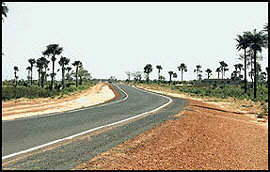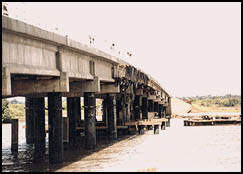 INFRASTRUCTURE, BUILDING THE FOUNDATION FOR THE FUTURE INFRASTRUCTURE, BUILDING THE FOUNDATION FOR THE FUTURE |

There is an obvious commitment to build, develop and improve on the infrastructure base of The Gambia as its development and maintenance attracts huge government investment and attention. Hundreds of million dollars have been pumped into various projects designed to enable the presence of the critical level of infrastructure that serves a necessary catalyst for improved and increasing private sector activity, especially as the country positions itself to becoming the trade gateway to the West African Market.

The campaign for infrastructure improvement pervades all of the Gambia's sectors, with an underlying effort to retain the best of its structures and reinvent the rest. Changes and developments are apace to endow every division of the economy with the appropriate indices that befit 21st century functioning. Road projects number into scores, sited at strategic areas in both urban and rural centres, they are designed to aid and ease transportation and distribution logistics, attract investments, stimulate agriculture and industry, promote the generation of employment and reduce congestion and traffic volumes on the existing roads. Other envisaged functions of the road projects are the enhancement of the tourism industry and encouragement of the export industry.

Some of the road projects involve the construction of new roads, giving a better and shorter link between destinations and opening up new areas for commercial activities. Others simply involve an extension, widening and strengthening of existing roads to adequately cater for increasing traffic. | There are also lesser roads projected to facilitate better access to health care, basic services and communication procedures around the country. Provincial metropolis are not left out, newly completed roads in the Upper River Division has opened up the border town of Basse for business, making it easier to transact goods and services between Gambia and Senegal.
Particular examples of the road projects include the Kombo Coastal Roads entailing the construction of a number of roads in and around the new Tourism Development Area (TDA). Almost completed, the roads make it possible for holidaymakers to journey directly form the planes to their hotels. It has, in addition, provided access to some of the most beautiful areas in The Gambia.

The Kerewan Road project, including a bridge, is billed for completion by February 2001. Jointly funded by the Gambian and Taiwanese governments, the project will facilitate access to an erstwhile difficult area, stimulate agriculture and industry and stem the rural-urban drift. Another $16 million investment will see the entire road stretch from the Airport to Banjul city transformed into a first-class dual-carriage way with a single-line extension going up to Madinabar, just started, the road is expected to link the export processing zones near the Banjul seaport at and the Yundum airport in 15 minutes, thus facilitating export and import procedures in the Trade Gateway initiative.
The government is also setting up a Highway Authority in collaboration with the European Union, the organisation will be responsible for developing, maintaining and sourcing funds for Gambia's road network. The Highway Authority is also expected to create the modalities and environment for private sector participation in road construction.

Air transport is also very high on schedule. There is an on-going modernisation project of $21 million aimed at improving and expanding Gambia's aviation facilities. The project will double the aircraft packing capacity; create additional taxiways to expedite movement on and off the runway and provide for the generation and operation of power supply system within the airport; an area welcoming private-sector involvement. Other components of the modernisation exercise will improve and permit for a technological update of Air Traffic Services both at equipment and management levels. Funded jointly by the Kuwaiti Fund and the Arab Bank for African Development, the project represents the second phase in the implementation of the Airport Master Plan, the first phase of which resulted in the new terminal building inaugurated in 1997. |

